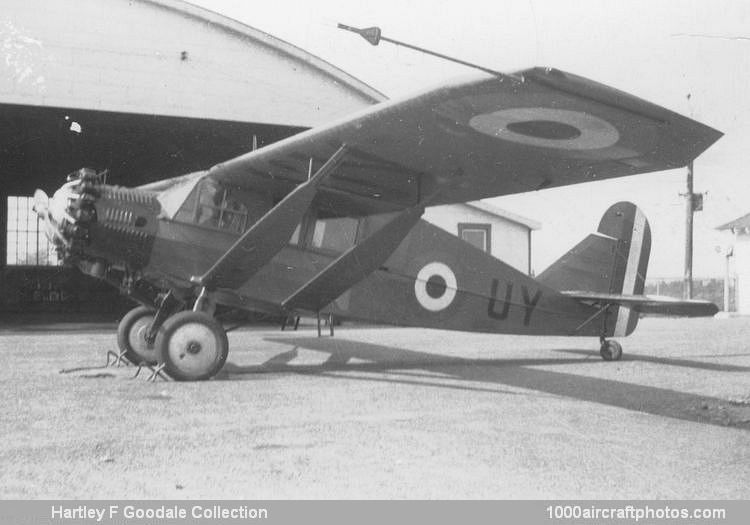11/15/2020. Remarks by Johan Visschedijk: "In 1922 Giuseppe Mario Bellanca designed the Bellanca CF, a strut-braced monoplane, with a 90 hp Anzani engine, which was built by the Bellanca-Roos Aeroplane Co. at Omaha, Nebraska. It carried five people, had a remarkable performance for its power, won efficiency contests, and established the general pattern of the Bellanca aircraft family that followed.
Late in 1924 Bellanca joined the Wright Aeronautical Corporation at Patterson, New Jersey, and designed a new aircraft to show off the J-4 Whirlwind engine. The new machine, the Wright-Bellanca WB-1, followed the same general design as the smaller Bellanca CF but included a cantilever landing gear with a massive metal fairing which earned it the sobriquet 'old tin pants'. The WB-1 performed very well but was written off in an accident in April 1926.
A second prototype, the WB-2, was already under construction and was very similar to the WB-1 but had a conventional landing gear. Its exceptional performance enabled it finally to better Lindbergh's New York-Paris distance record, and, as the Columbia, it later went on to become the first aircraft to make two Atlantic crossings.
The WB-2 Columbia was the prototype from which the Bellanca J, CH-200, CH-300, CH-300 Pacemaker and CH-400 Skyrocket all evolved. They established a remarkable reputation for load carrying which made them a natural choice for many long distance flights. On May 28, 1931, a slightly modified Bellanca CH-200 powered with a Packard DR-980 diesel engine established a non-refueled duration record for heavier-than-air machines.
With their outstanding performance the Bellancas were natural machines for Canadian requirements. The first, a CH-300, was imported in May 1929 and Bellanca Aircraft of Canada Ltd. was formed at Montreal about six months later to sell and service Bellancas and, when conditions warranted. a factory was proposed for their manufacture in Canada. R.B.C. Noorduyn represented the parent company in setting up the Canadian subsidiary, but the factory was never built.
Bellancas were well received in Canada and established a good reputation with both the civil operators and the RCAF which had ordered seven US-built Bellancas, a CH-300 and six CH-300 Pacemakers, the improved version of the CH-300. Six more CH-300 Pacemakers for the RCAF were ordered and Bellanca Aircraft of Canada handed over the order for their construction to Canadian Vickers Ltd., undoubtedly intending this as the initial step towards establishing a Canadian Bellanca factory.
The CH-300 Pacemaker was a typical Bellanca design of the period: a high-wing monoplane with lifting struts, and its construction, while sturdy, followed the Bellanca design philosophy of never putting in an unnecessary ounce of material and, where possible, making each item serve two purposes.
The actual construction was conventional, with wooden wings, a welded steel-tube fuselage, and tail surfaces of a combination of wood and steel. All components were fabric covered. The six RCAF Pacemakers were to have a wider than normal float track and the rear spreader bar was angled upward to a center point which was strut-braced to the fuselage. This arrangement was to provide a better view for the vertical aerial camera. All were to be supplied with two pairs of each of the following floats, Edo K.4650, Fairchild P.5L and the General Aircraft Builders 45, the different types being used for service trials, but shortly the wide-track Edo K.4650 floats became the standard.
Six welded fuselage frames were provided by the American company to avoid the expense of making a fuselage jig for the small order. The Canadian prototype, c/n CV 174 and registered G-CYVA, was launched into the Canadian Vickers basin on May 15, 1931. The date of the first flight and the name of the pilot has not been found. Possibly it was test flown on May 16 before being taken on strength by the RCAF on May 18. In RCAF service the Pacemakers served primarily as photographic aircraft.
One of the Canadian Vickers-built machines, the above pictured G-CYUY (which later was allotted the RCAF serial 602), had an experimental autopilot installed by the RCAF, the first such installation undertaken in Canada since the building of the Curtiss Canada in 1915. In 1937 the RCAF disposed of four Pacemakers, two of them Canadian Vickers-built, to Canadian Airways Ltd. and in CAL service they were employed both in aerial surveying and general bush flying. The last of the Canadian-built Pacemakers were struck off RCAF strength in 1940, and the last of the CAL machines was written off following an accident in December 1941.
No Canadian Vickers-built Pacemaker is known to be extant. In fact, it is surprising that not one of the record-making Bellancas has survived and the only museum specimen of this outstanding type is a US-built Pacemaker in the National Aeronautical Collection at Ottawa."
